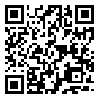BibTeX | RIS | EndNote | Medlars | ProCite | Reference Manager | RefWorks
Send citation to:
URL: http://ijpcp.iums.ac.ir/article-1-827-en.html
Abstract
Objectives: The distinction between intrinsic and extrinsic religious orientation appears to be useful in understanding the relation between religion and schizotypal personality as well as schizophrenia. The present study was carried out with the aim of examining the relation between religious orientation and schizotypal traits. Method: A sample of 210 individuals was selected from university students using random stratified sampling. Schizotypal Trait Questionnaire A form (STQ A) and Religious Attitude Testing Questionnaire (RATQ) were administered to the subjects. Results: All three schizotypal traits had significant relationship with extrinsic religious orientation (p<0.01). From among the schizotypal traits, “unusual perceptual experiences” was a suitable predictor for extrinsic religious orientation. Also, subjects with high schizotypal traits scored higher in extrinsic religious orientation, than subjects with low schizotypal traits. Conclusion: Since intrinsic religious orientation has no relationship with schizotypal traits, it could be concluded that despite being more religious, individuals with high schizotypal traits have more immature religiosity. Also, these findings are consistent with the view that intrinsic religiosity is associated with aspects of psychological well-being, and extrinsic religiosity is associated with poorer psychological well-being.
Received: 2009/12/1 | Published: 2009/12/15
| Rights and permissions | |
 |
This work is licensed under a Creative Commons Attribution-NonCommercial 4.0 International License. |



